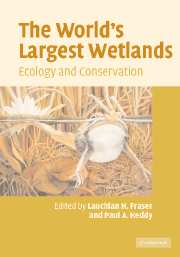Book contents
- Frontmatter
- Contents
- List of contributors
- Preface
- 1 Introduction: big is beautiful
- 2 The West Siberian Lowland
- 3 The Amazon River basin
- 4 The Hudson Bay Lowland
- 5 The Congo River basin
- 6 The Mackenzie River basin
- 7 The Pantanal
- 8 The Mississippi River alluvial plain
- 9 The Lake Chad basin
- 10 The River Nile basin
- 11 The prairie potholes of North America
- 12 The Magellanic moorland
- 13 The future of large wetlands: a global perspective
- Index
- References
4 - The Hudson Bay Lowland
Published online by Cambridge University Press: 10 August 2009
- Frontmatter
- Contents
- List of contributors
- Preface
- 1 Introduction: big is beautiful
- 2 The West Siberian Lowland
- 3 The Amazon River basin
- 4 The Hudson Bay Lowland
- 5 The Congo River basin
- 6 The Mackenzie River basin
- 7 The Pantanal
- 8 The Mississippi River alluvial plain
- 9 The Lake Chad basin
- 10 The River Nile basin
- 11 The prairie potholes of North America
- 12 The Magellanic moorland
- 13 The future of large wetlands: a global perspective
- Index
- References
Summary
Introduction
At the center of North America, lying south of Hudson Bay and west and south of James Bay (50° to 59° N, 76° to 96° W) is the world's third-largest wetland – the Hudson Bay Lowland (Zoltai 1973). This area is the size of Japan, larger than the United Kingdom or Germany but smaller than Zimbabwe, France, or Iraq.
The Lowland is located near the center of the former Laurentide Ice Sheet which formed during the late Wisconsin glaciation (Fig. 4.1) and is a legacy of that age (Zoltai 1973, Riley 2003). As the glacier receded, the depression left behind was inundated by melt waters which became the Tyrrell Sea (and later the modern Hudson Bay and James Bay). The Lowland has emerged over the last 7000 to 8000 years due to one of the continent's most-rapid rates of isostatic rebound (0.7 to 1.2 cm per year; Webber et al. 1970). At this rate, the Hudson Bay shoreline is moving northward 4 m per year. The maximum elevation, currently about 120 m above sea level, occurs at the Lowland's southern limit (Gray et al. 2001).
Stretching from Churchill to the Eastmain River (Fig. 4.2), the Hudson Bay Lowland covers 373 700 km2, or 3.7% of Canada (ESWG 1995). Over 80% of the Lowland lies in northern Ontario. It is bounded inland by exposed bedrock of the Precambrian Shield (Hustich 1957).
- Type
- Chapter
- Information
- The World's Largest WetlandsEcology and Conservation, pp. 118 - 148Publisher: Cambridge University PressPrint publication year: 2005
References
- 2
- Cited by



